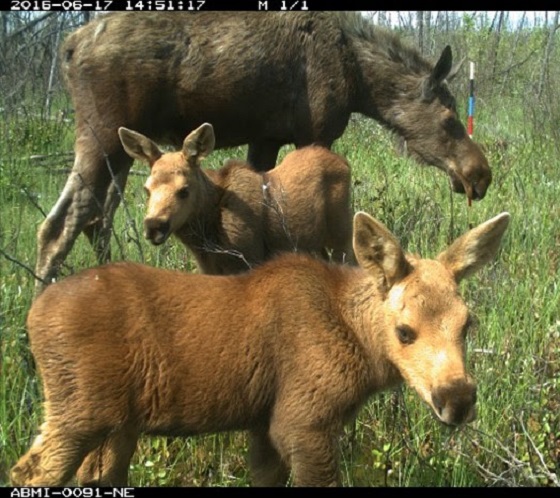Alberta
Alberta wildlife is ready for its close-up

Two moose calves in Wood Buffalo National Park. Photo credit: Alberta Biodiversity Monitoring Institute (ABMI).
Researchers are using remote cameras and cutting-edge tools to better study and monitor Alberta’s wildlife.
Researchers have used remote cameras to monitor wildlife in Alberta for many years, and for good reason: the technology is cost-effective, efficient and safe while enabling researchers to observe multiple species at the same time. However, collecting the data, coordinating with other researchers and reporting information effectively can be challenging.
Alberta’s government is teaming up with researchers to develop new resources and tools that will help wildlife experts work together, study and monitor bears, moose, cougars and other species from miles away.
“We are dedicated to wildlife conservation in Alberta. Led by our Chief Scientist, we are helping researchers better understand how wildlife is behaving and responding to the world around them to help make sure that Alberta’s amazing wildlife continue to grow and thrive for future generations.”
Remote cameras, also referred to as wildlife cameras or camera traps, are important tools for wildlife conservation. Their footage allows researchers to gain a better understanding of wildlife numbers, behaviours and ways to support conservation, all while keeping humans at a safe distance from the action.
The use of remote cameras by Alberta researchers, agencies, industry and the public has been steadily increasing. Alberta’s government and the Alberta Biodiversity Monitoring Institute (ABMI) have helped distribute remote cameras to every corner of the province, from the boreal forest in the north to the grasslands in the south, tracking more than 2,500 species.
Through a $66,000 grant by the Office of the Chief Scientist in 2022, Alberta Environment and Protected Areas, ABMI and the University of Alberta developed new remote camera standards and best practice resources, as well as training materials and tools for wildlife monitoring. As part of this project, Alberta released new remote camera survey guidelines and standards to help improve research, data collection and reporting. This work also improved Alberta’s understanding of what remote cameras are capturing, leading researchers to adjust the cameras and get a clearer picture of wildlife conditions.
This year, another $70,000 in government funding will go towards creating a new online tool to help researchers design remote camera projects, gather data and analyze it. With remote cameras placed throughout the province, this new online tool will help Alberta’s wildlife monitoring projects streamline and coordinate their efforts, regardless of their location, leading to better research.
“The Office of the Chief Scientist is proud to support research and guidance on use of cutting-edge technology to help improve monitoring of provincial wildlife populations. This work will produce results to support the management and conservation of mammals and other wildlife species in the province.”
“Alberta collects a vast amount of data using remote wildlife cameras. The funds provided by the chief scientist’s office will help us develop analysis frameworks that make the work done by individual organizations more consistent, repeatable and transparent. It also will help us better approaches for sharing data that drastically improve our ability to measure and manage at broad scales the species and ecosystems that we treasure.”
“The implications for data compatibility are huge: the more the standards are adopted by remote camera users, the larger the pool of data available to answer bigger and broader questions about wildlife. The Alberta remote camera steering committee is now working to develop accessible tools to support all users, from new to experienced users, in designing remote camera projects, data analysis and modelling. This will help more people conduct effective wildlife camera research and monitoring while also increasing the amount of data available to all.”
Quick facts
- The Office of the Chief Scientist coordinates the delivery of an environmental science program to provide scientifically rigorous data, information and reporting on the condition of Alberta’s environment.
- Grants through the Office of the Chief Scientist support evidence-informed decisions on programs and policies addressing Alberta’s natural resources.
- Remote cameras are most often used to monitor medium to larger mammals like white-tailed deer and bears but can also capture images of smaller creatures like birds and amphibians. They are also used to monitor elusive and far-ranging predators like wolverines and cougars.
- Typically, the camouflaged camera is mounted to a tree or post. Some are programmed to trigger when movement or a change in heat is detected in their field of view, while others are activated by a timer. The camera collects data on all species that pass by and stamps the video or picture with the date and time.
- The chief scientist and the Alberta government are committed to supporting research and delivering accessible reporting on the condition of Alberta’s environment.
Related information
- Remote Camera Survey Guidelines and Alberta Metadata Standards
- Wildlife Cameras for Adaptive Management
Multimedia
Alberta
Alberta’s vision for passenger rail

Alberta’s government will develop a Passenger Rail Master Plan as the foundation to advancing passenger rail in the province.
Since the early days of Alberta’s development, the province has been shaped by the iron rails that crisscross its landscape. The arrival of the transcontinental railway in the late 19th century brought about profound changes to the way of life, facilitating trade, settlement, and economic prosperity. Towns and cities sprung up along the tracks, serving as vital hubs for commerce and transportation.
Today, the legacy of rail continues to shape Alberta and the rest of Canada. While the modes of transportation may have evolved, the spirit of innovation and connectivity remains as strong as ever. As Alberta experiences record population growth and evolving transportation needs, advancing passenger rail infrastructure is essential for enhancing accessibility, efficiency, and connectivity across the province.
Alberta’s Passenger Rail Master Plan will look forward decades and identify concrete actions that can be taken now as well as in the future to build the optimal passenger rail system for the province. The Master Plan will assess the feasibility of passenger rail in the province, including regional (inter-city), commuter and high-speed services.
“A large and efficient passenger rail network stretching across the province has incredible potential. It represents a forward-looking vision and is a mobility solution for our rapidly growing province and I’m excited to watch this plan take shape and bring us into the future. There’s a lot of work ahead of us, but I’m confident that we will build the network Albertans need to improve daily life and work, boost the economy and take away the stress of long-distance travel.”
“Alberta already has significant public mass transit systems in Calgary and Edmonton for the provincial passenger rail system to build upon. The Master Plan will be a vital tool to guide the province on the next steps in advancing passenger rail. It will provide certainty to the rail sector and ensure the most effective use of tax dollars and government authorities. We look forward to hearing from Albertans and working with municipalities, Indigenous communities and the private sector in advancing passenger rail in the province.”
Passenger rail services connected to urban mass transit shapes and strengthens regional transportation systems, connects communities, supports jobs and the economy and improves access to housing.
“Canada’s railways appreciate the Alberta government’s efforts to conduct a fact-based study on the potential for passenger rail service that recognizes the essential need to protect current and future freight rail capacity. Any proposal to co-locate passenger service in freight corridors must demonstrate the ability to preserve the freight rail capacity required to move goods in support of the province’s economy, today and tomorrow. Rail is the greenest mode of ground transportation for both people and goods.”
The government’s vision is for an Alberta passenger rail system that includes public, private or hybrid passenger rail, including:
- a commuter rail system for the Calgary area that connects surrounding communities and the Calgary International Airport to downtown;
- a commuter rail system for the Edmonton area that connects surrounding communities and the Edmonton International Airport to downtown;
- regional rail lines from Calgary and Edmonton to the Rocky Mountain parks;
- a regional rail line between Calgary and Edmonton, with a local transit hub in Red Deer;
- municipal-led LRT systems in Calgary and Edmonton that integrate with the provincial passenger rail system; and
- rail hubs serving the major cities that would provide linkages between a commuter rail system, regional rail routes and municipal-led mass transit systems.
The vision includes a province-led “Metrolinx-like” Crown corporation with a mandate to develop the infrastructure and oversee daily operations, fare collection/booking systems, system maintenance, and planning for future system expansion.
“At VIA Rail our vision for integrated mobility means dreaming of a future where a passenger can easily switch between commuter rail, light transit, transit buses, and regional trains in an agile and simple way. We’ve already initiated a number of exchanges with partners, and we intend to step up the pace in the coming months and years. I can assure you that as integrated mobility becomes an increasingly important topic of conversation in Alberta, VIA Rail will be there to play a unifying role.”
Alberta’s Passenger Rail Master Plan will ensure government has the required information to make decisions based on where passenger rail delivers the best return on investment. The plan will provide a cost-benefit analysis and define what is required by government, including a governance and delivery model, legislation, funding, and staging to implement passenger rail in Alberta. This work will include a 15-year delivery plan that will prioritize and sequence investments.
“We are excited to see the province taking the next step in committing to regional and intercity rail. This Passenger Rail Master Plan aims to set out a vision for a comprehensive rail network in our province that’s long overdue. We are thrilled to see this process move forward.”
The Master Plan will take into account future growth, planning for the growing provincial population and considering the use of hydrogen-powered trains to ensure a robust and effective passenger rail system to serve Albertans for years to come.
Development of the Master Plan will include engagement with Albertans to gain their perspectives for the future of passenger rail in Alberta.
Alberta’s government has released a Request for Expression of Interest to seek world-class knowledge and consultant services as a first step toward the development of the Passenger Rail Master Plan for Alberta. Following this process, a Request for Proposal will be issued to select a consultant to develop the Passenger Rail Master Plan. The Master Plan is expected to be completed by summer 2025.
Quick facts
- Passenger rail includes:
- Commuter rail – passenger rail that primarily operates within a metropolitan area, connecting commuters to a central city from adjacent suburbs or surrounding commuter towns, and is often traditional heavy-rail
- Regional rail – passenger rail that operates beyond the limits of urban areas and provides inter-city passenger rail transport services and can be traditional heavy-rail or high-speed rail
- Light-rail transit (LRT) – urban passenger rail transit that typically operates small, frequent train service in an urban area. Calgary and Edmonton use LRT as part of their mass transit systems
- Passenger rail in Alberta is currently limited to two tourism-focused services, VIA Rail and Rocky Mountaineer, and LRT in Calgary and Edmonton.
- Budget 2024 includes $9 million to support the development of the Passenger Rail Master Plan this year.
Alberta
Three Calgary massage parlours linked to human trafficking investigation

News release from the Alberta Law Enforcement Response Team (ALERT)
ALERT’s Human Trafficking unit has searched and closed three Calgary massage parlours. A year-long investigation has linked the businesses and its owner to suspected human trafficking.
ALERT arrested Hai (Anna) Yan Ye on April 16, 2024 and charged the 48-year-old with advertising sexual services, drug offences and firearms offences. The investigation remains ongoing and further charges are being contemplated.
Ye was linked to three commercial properties and two homes that were allegedly being used for illegal sexual activities and services. The massage parlours were closed following search warrant executions carried out by ALERT, the Calgary Police Service, and the RCMP:
- Seagull Massage at 1034 8 Avenue SW;
- 128 Massage at 1935 37 Street SW; and
- The One Massage Centre at 1919 31 Street SE.
- 1100-block of Hidden Valley Drive; and
- 3100-block of 12 Avenue SW.
As result of the search warrants, ALERT also seized:
- $15,000 in suspected proceeds of crime;
- Shotgun with ammunition; and
- Various amounts of drugs.
“We believe that these were immigrants being exploited into the sex trade. This has been a common trend that takes advantage of their unfamiliarity and vulnerability,” said Staff Sergeant Gord MacDonald, ALERT Human Trafficking.
Four suspected victims were identified and provided resources by ALERT’s Safety Network Coordinators.
ALERT’s investigation dates back to February 2023 when a tip was received about suspicious activity taking place at the since-closed Moonlight Massage. That location was closed during the investigation, in December 2023, when the landlord identified illegal suites on the premises.
The investigation involved the close cooperation with City of Calgary Emergency Management and Community Safety, Alberta’s Safer Communities and Neighbourhoods (SCAN) team, Canada Border Services Agency (CBSA), and the RCMP.
Ye was released from custody on a number of court-imposed conditions.
Anyone with information about this investigation, or any case involving suspected human trafficking offences, is asked to call Crime Stoppers at 1-800-222-TIPS (8477) or the Calgary Police Service non-emergency line at 403-266-1234.
ALERT was established and is funded by the Alberta Government and is a compilation of the province’s most sophisticated law enforcement resources committed to tackling serious and organized crime.
-

 Automotive2 days ago
Automotive2 days agoCanadian interest in electric vehicles falls for second year in a row: survey
-

 Uncategorized22 hours ago
Uncategorized22 hours agoMaking Alberta a geothermal energy leader
-

 Business19 hours ago
Business19 hours agoParliamentary Budget Officer forecasts bigger deficits for years to come
-

 Business2 days ago
Business2 days agoOttawa’s capital gains tax hike—final nail in ‘business investment’ coffin
-

 Alberta1 day ago
Alberta1 day agoCanada’s postal service refuses to help with Trudeau’s gun ban buyback program: report
-

 COVID-191 day ago
COVID-191 day agoPeckford: Hallelujah! Supreme Court of Canada to hear Newfoundland and Labrador charter case
-

 Alberta2 days ago
Alberta2 days agoAlberta threatens to fight Trudeau government restrictions on Canada’s plastics industry
-

 Addictions18 hours ago
Addictions18 hours agoMust Watch: Addiction worker estimates 90% of “safer supply” drugs resold on black market







